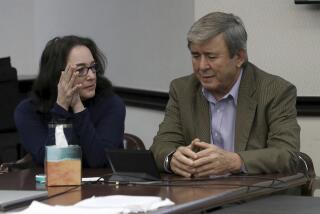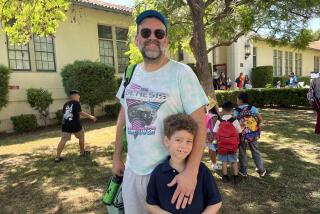In a Stunned Town, a Sad Cry: ‘We Are Changed Now’
- Share via
SANTEE, Calif. — The day after Charles Andrew Williams allegedly shot 15 people at Santana High School, the healers took over. For the most part, they had better luck working on broken bodies than they did the spirits of the little clouded town.
Grief counselors, ministers, psychologists--scores of would-be healers--were on hand to help at the crisis center and at the school. Almost 300 people came to the Sonrise Community Church, a supermarket turned church turned counsel central. Some people talked; others sat in silent company.
“I still didn’t believe it until I woke up this morning,” said Kristin Chalmers, a 14-year-old freshman at Santana. She wore overalls, her light brown hair dangling to her shoulders. She was the same girl, outwardly, that she had been the day before. The goal of the counseling was to reassemble her insides. If it worked, Chalmers said, it wasn’t yet apparent.
“It’s never going to feel like it was,” she said. “We are changed now.”
Around town, there were vivid expressions of anger at Williams and the friends who said he had told them what he planned to do.
Kim Fortin, 16, a sophomore, said: “If they come back, there will be fights. I think there will be a lot of dirty looks. If they had enough sense to pat him down, they knew that he had enough seriousness in his head to do it. I will just stare at them. How could they be so stupid? If they were good friends of his, they should have known about his bottled-up anger and how he could have taken it out.”
Tim Witthoft, 15, a sophomore, said if he had been in that situation, he would have gone directly to the office.
“That’s not being a narc. That’s respecting a school and making sure no one dies. Now these kids have to live with the fact that they could have stopped it.”
Karen Davis, mother of a senior at Santana, sat waiting for her daughter outside Sonrise church. It was dark and wet, and she sat still for the first time in two days, two days during which all she heard people say was, “It doesn’t happen here.”
“It doesn’t happen here?” she said. “He shot his friends. Now I’m starting to think, that kind of thing doesn’t happen in big cities. They have robberies, shootings. People don’t shoot their friends there.”
“You end up feeling so many things. You think you’re just going to feel angry, but you have pain, shock, sadness, frustration, embarrassment, disbelief, guilt. You feel guilt because this is supposed to be a close community. We don’t have adult bars that attract bad elements. We have a church that is the center of the community. Everybody comes here. Schools hold their talent shows here. You feel guilt because you are close and you feel like you really should have known that he needed something. That he was missing something in his soul.
“It’s hard. You don’t want to, but you have to look at it from his perspective. He wanted to belong to something, so he lashed out. He had an identity crisis. It’s confusing and it causes our own identity crisis. It makes us ask who are we. What did we do or not do. There’s no simple answer. That’s what’s hard. We’re not accustomed to complex answers, and it challenges your reality,” Davis said.
Earlier, across town, 150 people stood in a steady rain on the sidewalk in front of the school. There were students in letter jackets, and families and the ever-present counselors offering consolation.
They cried, hugged and laid flowers at the school sign, covering a large rock with bouquets.
Candles flickered in the rain. Dozens of Santee Sultan yellow and purple balloons danced in weather that California balloons don’t usually put up with.
In plain black letters, a sign pleaded, “Please students, guns are not the answer.”
Another sign had been nailed to a tree by Santana’s cross-town rivals at West Hills High School: “Sultans. Don’t lose hope. West Hills cares.” Others promised survival and prayer.
When students and parents later were allowed back into the school to collect their belongings, they gathered in the rain near the locked bathroom where the shooting began. They hugged and cried. Parents searched their children’s faces for a sign that this might help.
“It’s not going to happen again,” one parent said to his daughter.
They held their children and shook their heads in disbelief.
Officials from the town and the school had readied the school for their arrival by slapping fresh paint over the holes the bullets had left.
The blood had been cleaned up, the police tape removed. There was no evidence of the previous day’s carnage. As one sheriff’s deputy said, school officials made it look “as if it was 9 o’clock Monday morning.”
Nine o’clock--20 minutes before everything they had ever feared came true.
The campus was eerily quiet. Bikes were still chained to a rack. On lockers near the bathroom were signs for a blood drive previously scheduled for today.
As the man said, it looked like 9 o’clock.
It would in many ways, of course, never be 9 o’clock here, ever again.
*
Times staff writers Jessica Garrison and Ken Ellingwood contributed to this story.
More to Read
Sign up for Essential California
The most important California stories and recommendations in your inbox every morning.
You may occasionally receive promotional content from the Los Angeles Times.












